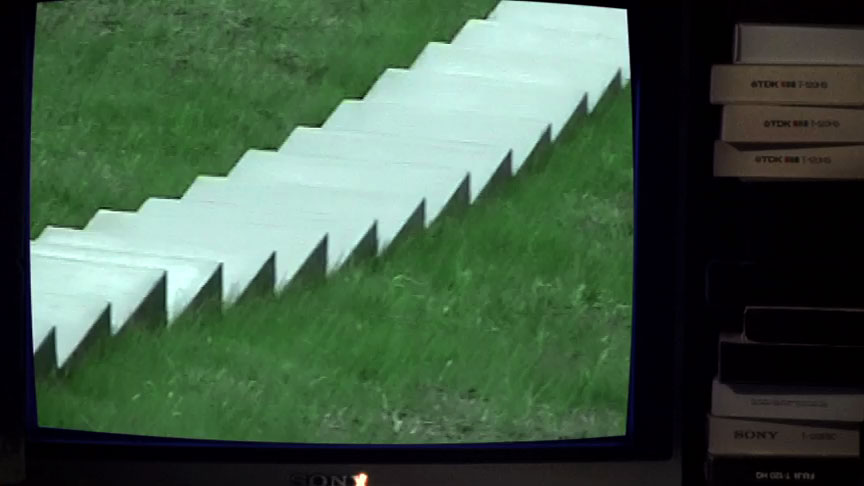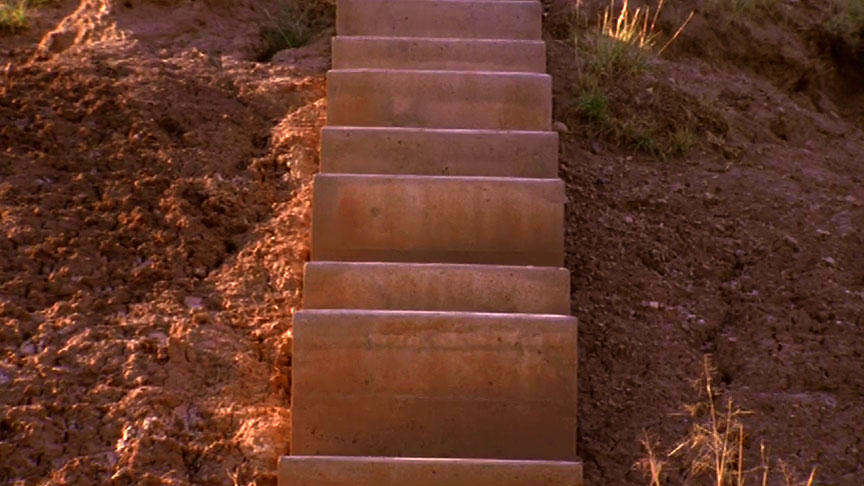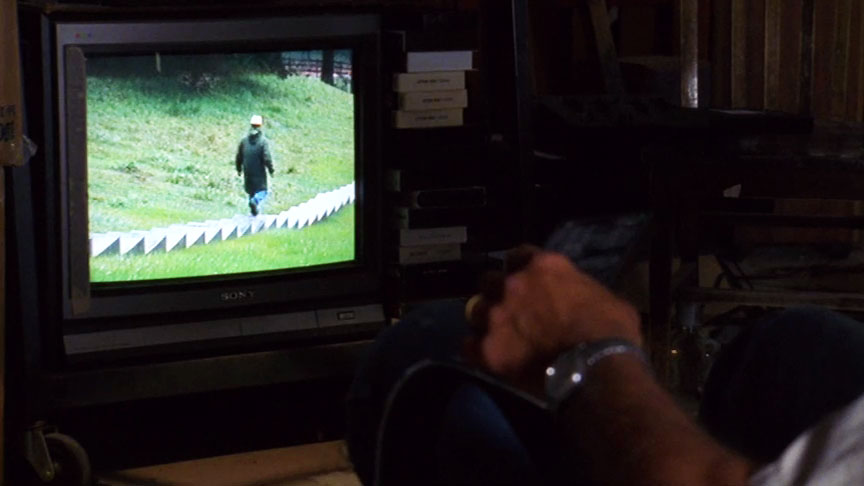Interview
Stairways

Bruce Nauman watches a video of Untitled (1998–99) in his studio, New Mexico, 2000. Production still from the Art in the Twenty-First Century Season 1 episode, Identity. © Art21, Inc. 2001.
In this interview, Bruce Nauman talks about how he came to use stairs as a recurring motif in his work.
ART21: Is there a story behind the stairs? How did this work come about?
NAUMAN: Steven and Nancy Oliver, in northern California, commissioned a number of outdoor works on their property by mostly California artists, or artists that have been in California. It’s a beautiful piece of property in a hilly little patch of ground above the Russian River. And when I drove up there to look at the property, as soon as we came onto the property, I thought, “Well, I should just build a stairway up to their house.” And didn’t mention that, but spent some time walking around the property and thinking about it, and came back and did the same and finally decided that’s what I’d do—build a stairway.
I decided the way I’d do it is to make the tread thirty inches square—or at least that’s what I ended up with, a thirty-inch-square tread—and the riser would be determined by the slope. So, I’d go out by thirty inches, and wherever that met the slope, that would be the height of the riser. So, we got a topographical map made, figured it out, and it runs six hundred and some feet of horizontal distance and almost two hundred feet of vertical distance, but a little under a one-in-three rise. And that’s what this average slope is.
So, I went ahead and built. I talked to them about it, and they said they were interested. So, I built these twenty-four steps here [in New Mexico]. I built this so that I’d have an idea of what the thing would kind of look like and feel like. And then they came out and looked at it, and it seemed good, so we went ahead and built it. Theirs comes out with almost three hundred steps, but again, the same average slope, so the smallest step is about an inch and a half and the biggest one is about twenty. That’s the way it worked out, on the property there. I was really pleased with the way it came out. It looks good.

Bruce Nauman. “Model” (1998), New Mexico, 2000. Production still from the Art in the Twenty-First Century Season 1 episode, Identity. © Art21, Inc. 2001.
ART21: What’s the experience of walking on it like?
NAUMAN: Of walking on it? It’s a lot of work, a lot more steps. The way the property runs, you can never see the whole thing at one time; there’s enough up and down as the slope changes. And so, that’s kind of neat because you have that ribbon in front of you, unveiling itself, or becoming exposed as you either go up or down. And there are some nice views of it as the driveway comes up in an S-curve. As you drive up, you see it from one side. And then you can see up and down it and then see it from another side. It doesn’t even really read as a stairway when you’re not standing on it and looking at it. I like that. It’s almost like a long, thin wall, and the scale kind of disappears. I like that about it very much.
ART21: Is there a particular way in which it works on your body or makes you think about your body as you walk down it?
NAUMAN: Because there is no regular rhythm to going up and down, you have to take each step and watch it. And so, it requires you to pay quite a lot of attention, even more down than up, because it’s a little less comfortable going down. But nothing is so abrupt that it totally catches you off guard. But you can feel yourself, your body, kind of measuring where your foot has to go at each step. You can’t ever quite find a rhythm, and it makes you very aware of yourself.

Bruce Nauman watches a video of Untitled (1998–99) in his studio, New Mexico, 2000. Production still from the Art in the Twenty-First Century Season 1 episode, Identity. © Art21, Inc. 2001.
ART21: Could you talk about that experience in relation to some of your other works, such as the corridor pieces where people can walk down these very narrow hallways?
NAUMAN: Yes, it’s the same, kind of. You’re now a participant in the work. You’re very aware as you walk up or down that your body has to make an adjustment at each step. And so, you have to figure when you can change your weight, and where your foot is going to be placed, and how high you step, or how far down you step. And nothing is so great that you have to struggle with it, but everything is a little bit of an adjustment. So, you’re kept a little off-balance all the time, adjusting yourself.
ART21: What makes this stairway a work of art and not just a bunch of stairs?
NAUMAN: I guess it’s the intention that changes it from a stairway to a stairway as a work of art—because I said so! (LAUGHS)
ART21: Did you research the history of stairs in art and architecture?
NAUMAN: Well, there are stairs as architecture that artists have done, and I was aware of those. I did some research on stairs. I was curious about how traditionally things were seen, and to try to shift that a little bit. Usually they’re made to be more comfortable, and this was intended to not be comfortable.
ART21: You once made a piece with rats in a maze, where you were controlling or trying to teach them how to navigate a maze. Do you see a relationship between that sort of activity and this work?
NAUMAN: (LAUGHS) I don’t . . . I don’t think so.
ART21: Well, there is a similar interest, it seems, in control and freedom.
NAUMAN: Yeah.
ART21: Wasn’t that work called Learned Helplessness in Rats? I guess I see a connection between rats, as subjects of an experiment, and your audience or the person walking down the steps, as taking part in an experiment in walking differently.
NAUMAN: Yeah, I’m hoping people can exercise a little more choice. And there’s no reward at the end of this one, except getting to the end.
ART21: Were you surprised at how well the work came out, in the end? Is it a major concern for you to make things that look beautiful, or are you generally surprised by it, just letting it happen?
NAUMAN: I’m surprised when the work appears beautiful, and very pleased. And I think work can be very good and very successful without being able to call it beautiful, although I’m not clear about that. The work is good when it has a certain completeness; and when it’s got a certain completeness, then it’s beautiful. So, I’m not sure how I’m seeing that. But maybe this has more of a traditional idea of beauty. It’s a very pleasurable sensation.

Bruce Nauman. “Model” (1998), New Mexico, 2000. Production still from the Art in the Twenty-First Century Season 1 episode, Identity. © Art21, Inc. 2001.
ART21: Is that what drew you to this ranch, to living all the way out here in New Mexico—the beauty of it all?
NAUMAN: Well, this is a beautiful spot, right here. And the whole ranch is beautiful. There are some more beautiful spots than others. There are a couple of major Indian ruins here. And almost every flat spot on the other side of the creek has got some sort of site. And when you go to those places, you know that the Indians knew that they were beautiful. That’s why they went to those spots; they went to beautiful places. They also went to the places where there was some water.
ART21: Has living in this environment altered your relationship to how you make work?
NAUMAN: Well, it lets me do the kinds of things outside that I couldn’t do if I lived in town, in the city. But it helps me to have a sense of place and security to go in the studio, because that’s the place where you make yourself insecure. Other than that, I don’t think there’s a direct influence on the work. Maybe that’s pretty direct; I don’t know.
This interview was originally published on PBS.org in September 2001 and was republished on Art21.org in November 2011.



